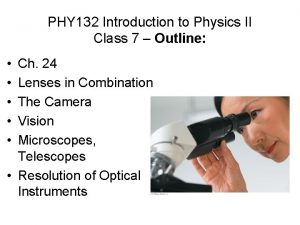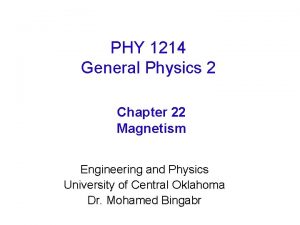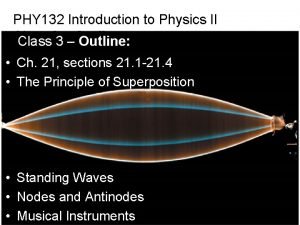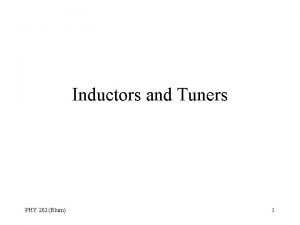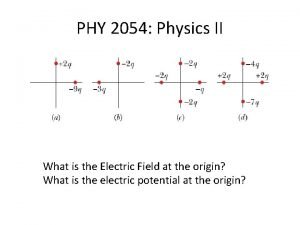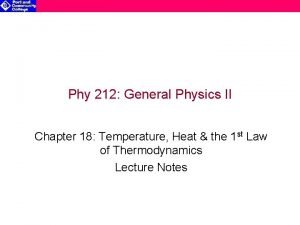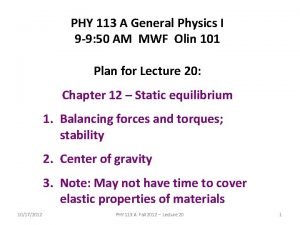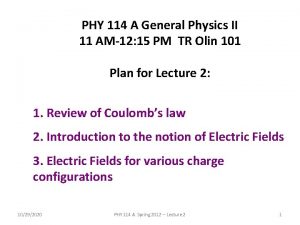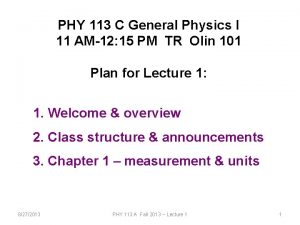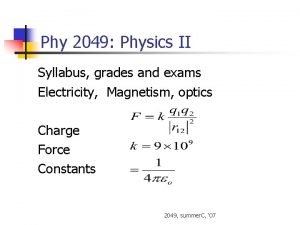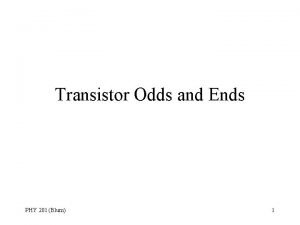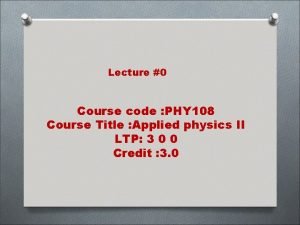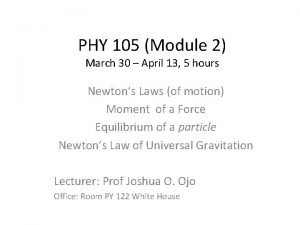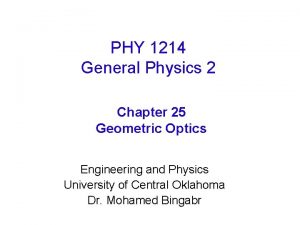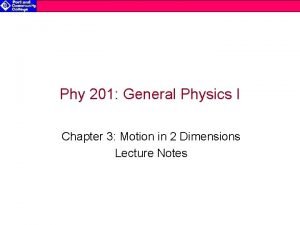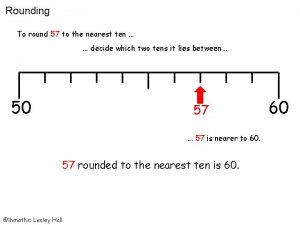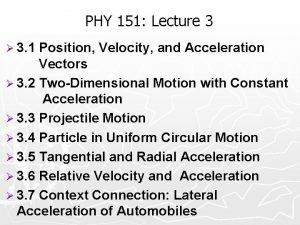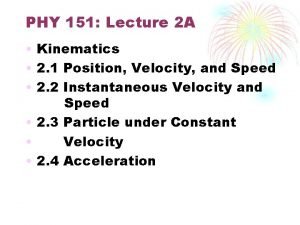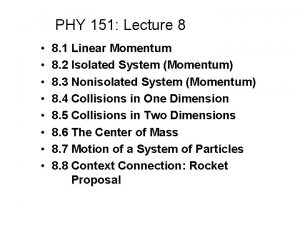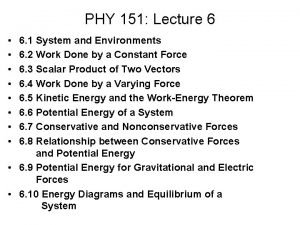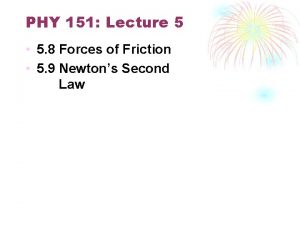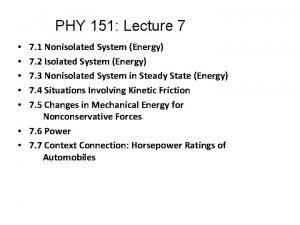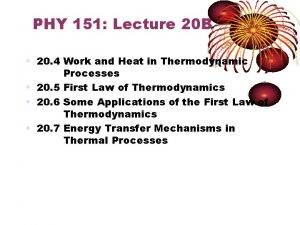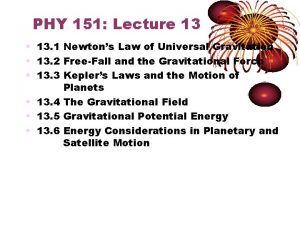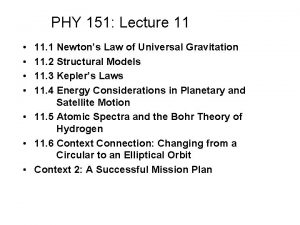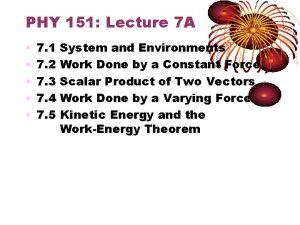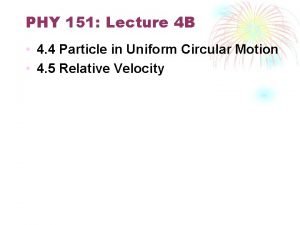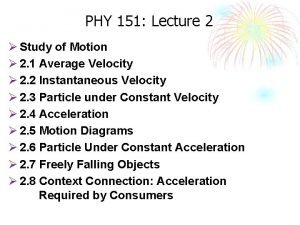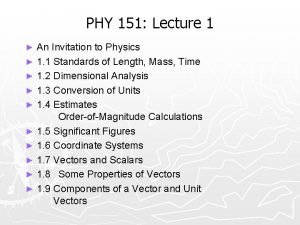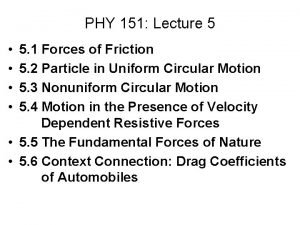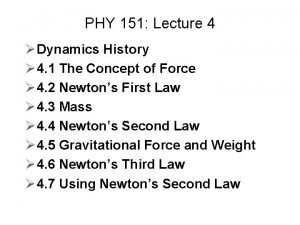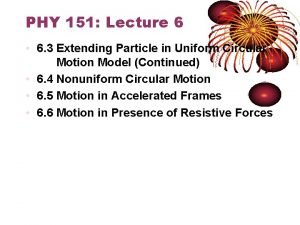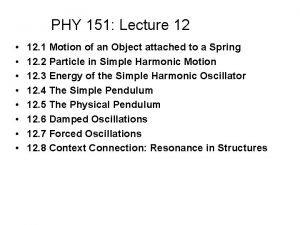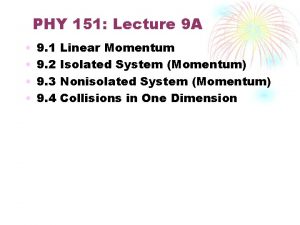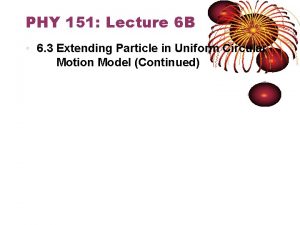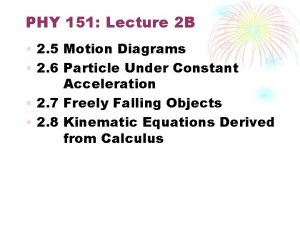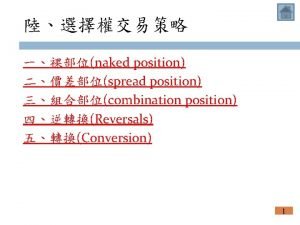PHY 151 Lecture 4 A 4 1 Position















































- Slides: 47

PHY 151: Lecture 4 A • 4. 1 Position, Velocity, and Acceleration Vectors • 4. 2 Two-Dimensional Motion with Constant Acceleration • 4. 3 Projectile Motion

PHY 151: Lecture 4 A Motion in Two Dimensions 4. 1 Position, Velocity, and Acceleration Vectors

Position and Displacement • The position of an object is described by its position vector, • The displacement of the object is defined as the change in its position •

General Motion Ideas • In two- or three-dimensional kinematics, everything is the same as in onedimensional motion except that we must now use full vector notation – Positive and negative signs are no longer sufficient to determine the direction

Average Velocity • The average velocity is the ratio of the displacement to the time interval for the displacement • The direction of the average velocity is the direction of the displacement vector • The average velocity between points is independent of the path taken – This is because it is dependent on the displacement, which is also independent of the path

Instantaneous Velocity - 1 • The instantaneous velocity is the limit of the average velocity as Δt approaches zero – As the time interval becomes smaller, the direction of the displacement approaches that of the line tangent to the curve

Instantaneous Velocity - 2 • The direction of the instantaneous velocity vector at any point in a particle’s path is along a line tangent to the path at that point and in the direction of motion • The magnitude of the instantaneous velocity vector is the speed – The speed is a scalar quantity

Average Acceleration - 1 • The average acceleration of a particle as it moves is defined as the change in the instantaneous velocity vector divided by the time interval during which that change occurs

Average Acceleration - 2 • As a particle moves, the direction of the change in velocity is found by vector subtraction • The average acceleration is a vector quantity directed along

Instantaneous Acceleration • The instantaneous acceleration is the limiting value of the ratio as Δt approaches zero – The instantaneous equals the derivative of the velocity vector with respect to time

Producing An Acceleration • Various changes in a particle’s motion may produce an acceleration – The magnitude of the velocity vector may change – The direction of the velocity vector may change • Even if the magnitude remains constant – Both may change simultaneously

PHY 151: Lecture 4 A Motion in Two Dimensions 4. 2 Two-Dimensional Motion with Constant Acceleration

Kinematic Equations for Two-Dimensional Motion • When the two-dimensional motion has a constant acceleration, a series of equations can be developed that describe the motion • These equations will be similar to those of onedimensional kinematics • Motion in two dimensions can be modeled as two independent motions in each of the two perpendicular directions associated with the x and y axes – Any influence in the y direction does not affect the motion in the x direction

Kinematic Equations - 2 • Position vector for a particle moving in the xy plane • The velocity vector can be found from the position vector – Since acceleration is constant, we can also find an expression for the velocity as a function of time:

Kinematic Equations 3 • The position vector can also be expressed as a function of time: – – This indicates that the position vector is the sum of three other vectors: • The initial position vector • The displacement resulting from the initial velocity • The displacement resulting from the acceleration

Kinematic Equations, Graphical Representation of Final Velocity • The velocity vector can be represented by its components • is generally not along the direction of either or

Kinematic Equations, Graphical Representation of Final Position • The vector representation of the position vector • is generally not along the same direction as , or • and are generally not in the same direction

PHY 151: Lecture 4 A Motion in Two Dimensions 4. 3 Projectile Motion

Projectile Motion - 1 • An object may move in both the x and y directions simultaneously • The form of two-dimensional motion we will deal with is called projectile motion

Assumptions of Projectile Motion • Horizontal § vxf = vxi § ax = 0 m/s 2 • Vertical § § § ay = -9. 8 m/s 2 g = acceleration of gravity = 9. 8 m/s 2 g is positive Use g as ay = –g No air resistance

Projectile Motion Diagram

Acceleration at the Highest Point • The vertical velocity is zero at the top • The acceleration is not zero anywhere along the trajectory – If the projectile experienced zero acceleration at the highest point, its velocity at the point would not change • The projectile would move with a constant horizontal velocity from that point on

Analyzing Projectile Motion • Consider the motion as the superposition of the motions in the x- and y-directions • The actual position at any time is given by: • The initial velocity can be expressed in terms of its components. – vxi = vi cos q and vyi = vi sin q • The x-direction has constant velocity – ax = 0 • The y-direction is free fall – ay = -g

Projectile Motion Vectors • • The final position is the vector sum of the initial position, the position resulting from the initial velocity and the position resulting from the acceleration

Range and Maximum Height of a Projectile • When analyzing projectile motion, two characteristics are of special interest • The range, R, is the horizontal distance of the projectile • The maximum height the projectile reaches is h

Height of a Projectile, equation • The maximum height of the projectile can be found in terms of the initial velocity vector: • This equation is valid only for symmetric motion

Description of Range • • • Object is fired at angle q to horizontal Object is fired at a height 0 Object returns to the height 0 This is a symmetric trajectory Trajectory is a parabola Horizontal distance from starting to final position is the Range

Range Formula • y-motion gives time-of-flight § § y = visinqt – (1/2)gt 2 0 = visinq – (1/2)gt t =2 visinq/g • x-motion give Range, R § § x = R= (vicosq)t R = (vicosq)(2 visinq/g) R=(vi 2/g)2 sinqcosq R=(vi 2/g)sin 2 q

Range Formula – Example 1 • An M 16 bullet has an initial velocity of 950 m/s • The bullet is fired at an angle of 450 • What is it’s maximum range? ØR=(vi 2/g)sin 2 q ØR=(9502/9. 8)sin(2 x 45) = 92. 1 km

Range Formula – Example 2 • A motorcycle travelling at 50 m/s wants to jump a gap to 200 m • At what angle should the motorcycle be launched? ØR=(vi 2/g)sin(2 q) Ø 200=(2500/9. 8)sin(2 q) Øsin(2 q) = 200(9. 8)/2500 = 0. 785 Øq = 25. 860 and 64. 140

More About the Range of a Projectile

2 -Dimensions Projectile Motion – Curve • x-motion equations § vx = vicosq § x = (vicosq)t • y-motion equations § vy = visinq - gt § y = visinqt – (1/2)gt 2 • Solve for t in terms of x gives • This is a parabola

Angle for Maximum Range • Maximum range when sin(2 q) = 1 • 2 q = 900 • q = 450

Range of a Projectile, final • The maximum range occurs at qi = 45 o • Complementary angles will produce the same range – The maximum height will be different for the two angles – The times of the flight will be different for the two angles

Projectile Motion – Problem Solving Hints • Categorize – Confirm air resistance is neglected – Select a coordinate system with x in the horizontal and y in the vertical direction • Analyze – If the initial velocity is given, resolve it into x and y components – Treat the horizontal and vertical motions independently – Analyze the horizontal motion with the particle-underconstant-velocity model – Analyze the vertical motion with the particle-underconstant-acceleration model – Remember that both directions share the same time

Non-Symmetric Projectile Motion

Projectile Motion – Example 1 a • • Ball with horizontal speed of 1. 5 m/s rolls off bench 2. 0 m high (a) How long will it take the ball to reach floor? Ø Horizontal xf = xi + vt xi = 0 xf = ? v = 1. 5 t=? xf = 0 + 1. 5 t Equation has xf, t Ø Vertical vf = vi + at yf = yi + vit + ½at 2 vf 2 = vi 2 + 2 a(yf – yi) yi = 2 yf = 0 vi = 0 vf = ? a = -9. 8 t = ? vf = 0 – 9. 8 t Equation has vf, t 0 = 2 + 0 t + ½(-9. 8)t 2 Equation has t 02 = 402+2(-9. 8)(yf– 100) Equation has yf 0 = 2 + 0 t + ½(-9. 8)t 2 t = sqrt(-4/-9. 8) = 0. 64 s

2 -Dimensions Projectile Motion – Example 1 b • Ball with horizontal speed of 1. 5 m/s rolls off bench 2. 0 m high • How far from point on floor directly below edge of the bench will ball land? Ø Horizontal xf = xi + vt xi = 0 xf = ? v = 1. 5 t = 0. 64 xf = 0 + 1. 5(0. 64) Equation has xf = 0 + 1. 5(0. 64) = 0. 96 m

2 -Dimensions Projectile Motion – Example 2 (Find Time) • Ball rolls horizontally with speed of 7. 6 m/s off edge of tall platform • Ball lands 8. 7 m from the point on ground directly below edge of platform • What is height of platform? Ø Horizontal xf = xi + vt xi = 0 xf = 8. 7 v = 7. 6 t = ? 8. 7 = 0 + 7. 6 t t = 8. 7 / 7. 6 = 1. 14 s Equation has t

Projectile Motion – Example 2 (Find Height) • Ball rolls horizontally with speed of 7. 6 m/s off edge of tall platform • Ball lands 8. 7 m from point on ground directly below platform • What is height of platform? Ø Vertical vf = vi + at yf = yi + vit + ½at 2 vf 2 = vi 2 + 2 a(yf – yi) yi = ? yf = 0 vi = 0 vf = ? a = -9. 8 t = 1. 14 vf = 0 – 9. 8(1. 14) Equation has vf 0 = yi + 0(1. 14) + ½(-9. 8)(1. 14)2 Equation has yi vf 2 = 02+2(-9. 8)(yf–yi) Equation has yi, yf, vf 0 = yi + 0(1. 14) + ½(-9. 8)(1. 14)2 yi =-(1/2)(-9. 8)(1. 14)2 = 6. 37 m

Projectile Motion – Example 3 a • • A rifle fires a bullet at a speed of 250 m/s at an angle of 370 above the horizontal. (a) What height does the bullet reach? Ø Horizontal Ø xf = xi + vt xi = 0 v=250 cos(37)=199. 7 xf = 0 + 199. 7 t Vertical vf = vi + at yf = yi + vit + ½at 2 vf 2 = vi 2 + 2 a(yf – yi) yi = 0 vi = 250 sin(37)=150. 5 a = -9. 8 0 = 150. 5 – 9. 8 t yf = 0 + 150. 5 t + ½(-9. 8)t 2 02 = 150. 52+2(-9. 8)(yf– 0) yf =-150. 52/2/-9. 8 = 1155 m/s xf = ? t=? Equation has xf, t yf = ? vf = 0 t = 1. 14 Equation has t Equation has yf, t Equation has yf

Projectile Motion – Example 3 b • • A rifle fires a bullet at a speed of 250 m/s at an angle of 370 above the horizontal. (b) How long is the bullet in the air? Ø Horizontal xf = xi + vt xi = 0 xf = ? v=250 cos(37)=199. 7 t = ? xf = 0 + 199. 7 t Equation has xf, t Ø Vertical vf = vi + at yf = yi + vit + ½at 2 vf 2 = vi 2 + 2 a(yf – yi) yi = 0 yf = 0 vi = 250 sin(37)=150. 5 vf = ? a = -9. 8 t=? vf = 150. 5 – 9. 8 t Equation has vf, t 0 = 0 + 150. 5 t + ½(-9. 8)t 2 Equation has t vf 2 = 150. 52+2(-9. 8)(0– 0) Equation has vf 0 = 0 + 150. 5 t + ½(-9. 8)t 2 t = -150. 5(2)/-9. 8 = 30. 7 s

Projectile Motion – Example 3 c • • A rifle fires a bullet at a speed of 250 m/s at an angle of 370 above the horizontal. (b) What is the balls range? Ø Horizontal xf = xi + vt xi = 0 xf = ? v=250 cos(37)=199. 7 t = 30. 7 xf = 0 + 199. 7(30. 7) Equation has xf Ø Vertical vf = vi + at yf = yi + vit + ½at 2 vf 2 = vi 2 + 2 a(yf – yi) yi = 0 yf = 0 vi = 250 sin(37)=150. 5 vf = ? a = -9. 8 t = 30. 7 vf = 150. 5 – 9. 8(30. 7) Equation has vf 0=0+150. 5(30. 7)+½(-9. 8)(30. 7)2 Can’t use equation vf 2 = 150. 52+2(-9. 8)(0– 0) Equation has vf xf = 0 + 199. 7(30. 7) = 6130. 8 m

2 -Dimension Projectile Motion – Example 4 a (Find Time) • Batter hits a ball giving it a velocity of 50 m/s • At an angle of 36. 9 degrees to the horizontal • (a) Find height at which it hits fence at distance 180 m? • Horizontal xf = xi + vt xi = 0 xf = 180 v = 50 cos 36. 9 = 40 t = ? 180 = 0 + 40 t t = 180 / 40 = 4. 5 s Equation has t

Projectile Motion – Example 4 a (Find Height) • Batter hits a ball giving it a velocity of 50 m/s • At an angle of 36. 9 degrees to the horizontal • (a) Find height at which it hits fence at distance 180 m? Ø Vertical vf = vi + at yf = yi + vit + ½at 2 vf 2 = vi 2 + 2 a(yf – yi) yi = 0 yf = ? vi = 50 sin 36. 9=30 vf = ? a = -9. 8 t = 4. 5 vf = 30 – 9. 8(4. 5) Equation has vf yf = 0 + 30(4. 5) + ½(-9. 8)(4. 5)2 Equation has yi vf 2 = 302+2(-9. 8)(yf – 0) Equation has yf, vf yf = 0 + 30(4. 5) + ½(-9. 8)(4. 5)2 = 35. 8 m

2 -Dimensions Projectile Motion – Example 4 b (Find Velocity 1) • Batter hits a ball giving it a velocity of 50 m/s • At an angle of 36. 9 degrees to the horizontal • (b) What is velocity at which it hits a fence at distance of 180 m? Ø Vertical vf = vi + at yf = yi + vit + ½at 2 vf 2 = vi 2 + 2 a(yf – yi) yi = 0 yf = 35. 8 vi = 50 sin 36. 9=30 vf = ? a = -9. 8 t = 4. 5 vf = 30 – 9. 8(4. 5) Equation has vf 35. 8 = 0 + 30(4. 5) + ½(-9. 8)(4. 5)2 Can’t use equation vf 2 = 302+2(-9. 8)(35. 8 – 0) Equation has vf = 30 – 9. 8(4. 5) = -14. 1 m/s

2 -Dimensions Projectile Motion – Example 4 b (Find Velocity 2) • Batter hits a ball giving it a velocity of 50 m/s • At an angle of 36. 90 to the horizontal • (b) What is velocity at which it hits a fence at distance of 180 m? Øvy = -14. 1 m/s Øvx = 40 Øv = sqrt(402 + (-14. 1)2) = 42. 4 m/s Øq = tan-1(14. 1/40) = 19. 10 Øvy is negative, therefore q points into fourth quadrant
 Nearsightedness physics
Nearsightedness physics Glisside
Glisside 01:640:244 lecture notes - lecture 15: plat, idah, farad
01:640:244 lecture notes - lecture 15: plat, idah, farad Phy tgen
Phy tgen Phy 131 asu
Phy 131 asu Loncapa fsu
Loncapa fsu General physics
General physics Phy 1214
Phy 1214 Phy 2049
Phy 2049 Phy 132
Phy 132 Phy
Phy Phy 221 msu
Phy 221 msu Fizik ii
Fizik ii Ddr phy architecture
Ddr phy architecture Phy 212
Phy 212 2012 phy
2012 phy Phy 131 past papers
Phy 131 past papers Phy
Phy Phy
Phy Physics 2
Physics 2 Phy 1214
Phy 1214 Life phy
Life phy Phy theorem
Phy theorem Phy 2049
Phy 2049 Phy 205
Phy 205 Phy 1214
Phy 1214 Law of motion
Law of motion Pa msu
Pa msu Phy
Phy Phy 108
Phy 108 Phy-105 5 discussion
Phy-105 5 discussion Phy1501
Phy1501 Phy113
Phy113 Real image
Real image Eye phy
Eye phy Vx=vox+axt
Vx=vox+axt Complete motion diagram
Complete motion diagram Great orthogonality theorem
Great orthogonality theorem Atm basics
Atm basics Mcb 151 uiuc
Mcb 151 uiuc 118/151
118/151 Conforme a tua infinita graça numero
Conforme a tua infinita graça numero Sjsu cs 151
Sjsu cs 151 Alan ableson queens
Alan ableson queens 326 to the nearest 100
326 to the nearest 100 Determinants of consumption
Determinants of consumption Jarecki uci
Jarecki uci Econ 151
Econ 151
